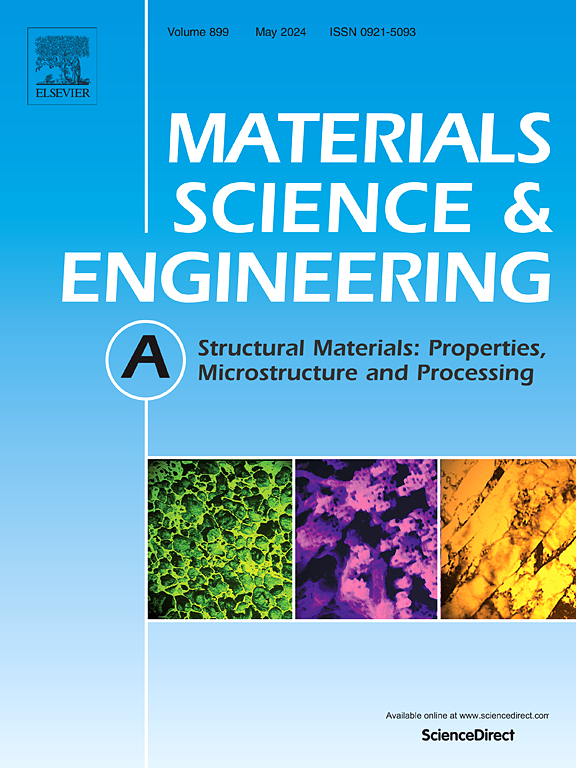An insight into high temperature stability of microstructure and mechanical properties of bulk nanocrystalline (AlCoCrCuFeNi)99B1 high entropy alloy processed by mechanical alloying and spark plasma sintering
IF 6.1
2区 材料科学
Q1 MATERIALS SCIENCE, MULTIDISCIPLINARY
引用次数: 0
Abstract
Bulk nanocrystalline (AlCoCrCuFeNi)99B1 high entropy alloy (B-doped HEA) and the corresponding base alloy (AlCoCrCuFeNi) with >98 % of theoretical density have been synthesized by mechanical alloying followed by spark plasma sintering (SPS). A detailed analysis of phase constituents in both B-doped HEA and base alloy has revealed the presence of a phases mixture comprising FCC (Cu-rich F1), ordered FCC (Ni3Al-type F2), BCC (Cr-rich) and ordered BCC (NiAl-type B2), with a mean grain size of approximately ∼ 63 nm, along with the dispersion of WC. Furthermore, the B-doped HEA has exhibited superior hardness (∼6.98 ± 0.08 GPa) and compressive strength (>2 GPa) indicating enhancements of ∼5.9 % and ∼21.1 %, respectively compared to the base alloy. The effect of B-addition on thermal stability has been evaluated by annealing both the alloys at 1173 K for 1–10 h, and comparing their post-anneal microstructures and hardness. A quantitative analysis of the post-anneal microstructures has shown a negligible variation in the relative phase fractions of the B-doped HEA, contrary to the monotonic increase in the FCC phase fraction of the base alloy with increasing duration of annealing. The segregation of B at the phase boundaries appears to have inhibited both phase decomposition and grain growth, leading to superior thermal stability with retention of the nanocrystalline microstructure throughout the holding period (with a mean grain size of ∼76 nm after 10 h). Owing to higher thermal stability, 10 h annealing has led to a lower (∼3 %) drop in hardness in the B-doped HEA compared to the base alloy, causing the hardness difference between these alloys to increase to ∼8 %. Analysis of the strengthening mechanisms suggests that the Hall-Petch mechanism is the key contributor to strength, which is further augmented by the Orowan strengthening contributed by the dispersed Cr7C3 particles.
机械合金化和火花等离子烧结制备大块纳米晶(AlCoCrCuFeNi)99B1高熵合金的显微组织和力学性能的高温稳定性研究
采用机械合金化-火花等离子烧结(SPS)法制备了体积纳米晶(AlCoCrCuFeNi)99B1高熵合金(b掺杂HEA)和相应的基体合金(AlCoCrCuFeNi),其密度达到理论密度的98%。对b掺杂HEA和基体合金的相组成进行了详细分析,发现存在由FCC(富cu F1)、有序FCC (ni3al型F2)、BCC(富cr)和有序BCC (nial型B2)组成的相混合物,平均晶粒尺寸约为~ 63 nm,并伴有WC的分散。此外,b掺杂的HEA具有优异的硬度(~ 6.98±0.08 GPa)和抗压强度(>2 GPa),与基体合金相比分别提高了~ 5.9%和~ 21.1%。通过在1173 K下退火1 ~ 10 h,比较合金退火后的显微组织和硬度,研究了添加b对合金热稳定性的影响。退火后显微组织的定量分析表明,b掺杂HEA的相对相分数变化可以忽略不计,相反,基体合金的FCC相分数随着退火时间的增加而单调增加。B在相界的偏析似乎抑制了相分解和晶粒生长,导致优异的热稳定性,并在整个保温期间保持纳米晶微观结构(10 h后平均晶粒尺寸为~ 76 nm)。由于具有更高的热稳定性,10 h退火导致b掺杂HEA的硬度下降比基体合金低(~ 3%),导致这些合金之间的硬度差异增加到~ 8%。强化机制分析表明,Hall-Petch机制是增强材料强度的关键机制,分散的Cr7C3颗粒的Orowan强化进一步增强了霍尔- petch机制。
本文章由计算机程序翻译,如有差异,请以英文原文为准。
求助全文
约1分钟内获得全文
求助全文
来源期刊

Materials Science and Engineering: A
工程技术-材料科学:综合
CiteScore
11.50
自引率
15.60%
发文量
1811
审稿时长
31 days
期刊介绍:
Materials Science and Engineering A provides an international medium for the publication of theoretical and experimental studies related to the load-bearing capacity of materials as influenced by their basic properties, processing history, microstructure and operating environment. Appropriate submissions to Materials Science and Engineering A should include scientific and/or engineering factors which affect the microstructure - strength relationships of materials and report the changes to mechanical behavior.
 求助内容:
求助内容: 应助结果提醒方式:
应助结果提醒方式:


